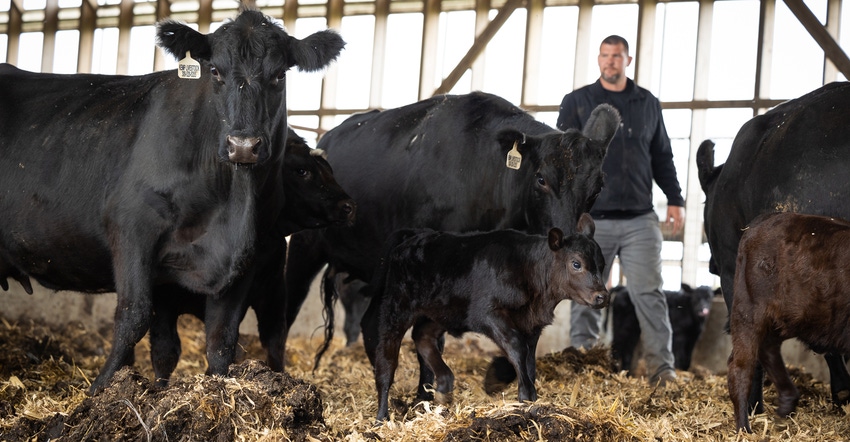December 28, 2022

Raising cattle in the Land of Lincoln presents a unique set of challenges and opportunities for cow-calf producers — particularly the weather, land availability and feed. As calving season approaches, a University of Illinois Extension study aimed to find answers on the effects of moving the cow herd indoors.
Travis Meteer, University of Illinois Extension beef specialist, says the survey was done in response to questions he’s received from producers looking to expand who are curious about the impacts of confinement on management and herd health.
“High land prices, limited pasture availability and high feed costs have made it a challenge for Illinois cow-calf producers to expand their farms,” Meteer says. “We wanted to dive into what early adopters have done and how they’ve successfully implemented this alternative indoor system.”
They surveyed 20 cattle producers across the state who house cows in a monoslope barn, gable frame barn or hoop barn, asking questions concerning technology, herd health, manure management, cover crops usage and feed storage.
“None of the producers surveyed answered that their cows were underconditioned,” Meteer says. “When cows are out consuming forage, subject to Mother Nature with things like rainfall and drought, it’s not uncommon to have cows that come in skinny or underconditioned. By keeping cows in more of a controlled environment, we guard ourselves against that.”
There is also level of convenience with having cows and calves confined to one spot; however, other aspects of herd management take priority. When animals are more densely housed, it is important to work with a veterinarian on preventative calf health measures, and a nutritionist for adequate rations and bedding supervision for a clean and healthy environment.
“When you go from more of a pasture-based system to more intensely managed confinement, there are different challenges,” Meteer explains. “It’s not necessarily a lower-effort system, it’s that you just have to put your effort in different spots than when you have cattle out on pastures.”
And Illinois cattle producers are noticing the benefits.
“In the Midwest, especially in central Illinois, we have an abundant supply of cornstalks for bedding and a lot of byproduct feeds,” Meteer says. “We also have fertile soils that can produce high-yielding forages like corn silage or cover crop forages.”
Plus, calving outdoors in Midwest weather presents its own trials.
“Producers identified calving in mud and poor weather conditions to be a challenge,” he says. “In Illinois, our wet, muddy winter weather is not favorable to calving beef cows.”
Not only do barns provide a better situation for the cattle in the winter months, they also provide a cooler, shady setting during summertime temperatures. Reduced fly pressure is an unexpected bonus to cow housing due to good ventilation and an environment that isn’t conducive to fly reproduction.
“Fewer flies in a barn isn’t something that most people would expect,” Meteer says. “Flies like to lay eggs either in an undisturbed manure pad or kind of a straw-like area. There really isn’t undisturbed manure in confinement because cattle walk through manure pads and break them up.”
When considering cow housing, Meteer says to look for opportunities to add value to the farm, such as adding manure to crop land or seeking cheap feed sources.
“On the cow-calf side, there are a lot of different ways to do it,” he says. “It’s not the same for every farm. I like the fact that different farms have been able to find different opportunities to be more competitive. It’s definitely not a cookie-cutter system.”
U of I Extension cow housing survey findings
Here are more findings from a survey of cattle producers who use monoslope, gable frame or hoop barns, conducted by University of Illinois Extension:
Most producers with cow inventories over 150 head house cows in a monoslope or gable frame barn.
Hoop barn users are more likely to have lime-based flooring and drylot access.
Most respondents have concrete bed-pack flooring and use cornstalks as bedding.
Monoslope and gable frame users are more likely to creep-feed than hoop barn users.
All producers report cows are either overconditioned or properly-conditioned in confinement.
No monoslope users report calf respiratory issues.
All respondents report lower pressure from flies in barns compared to a drylot or pasture scenario.
Most respondents raise cover crops as feed or forage.
Most respondents use technology like cameras and artificial insemination, etc.
About the Author(s)
You May Also Like






